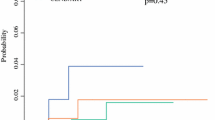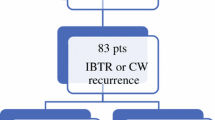Abstract
Purpose
Regional failure rates are low in patients with a positive sentinel lymph node biopsy (SLNB) who undergo breast-conserving therapy without axillary lymph node dissection (ALND). The applicability of these findings to total mastectomy (TM) patients is not established. Our aims were to evaluate the characteristics and outcomes of SLNB-positive TM patients who did not receive axillary-specific treatment and to compare them to similar patients who underwent breast-conserving surgery (BCS).
Methods
A total of 535 patients with early-stage breast cancer who underwent definitive breast surgery (210 TM, 325 BCS), had a positive SLNB and did not receive ALND between 1997 and 2009 were identified from an institutional database. Characteristics and outcomes were compared between the TM and BCS groups.
Results
Most patients had stage I to IIA, estrogen receptor–positive, progesterone receptor–positive, Her2-negative invasive ductal carcinoma, with minimal nodal disease. Compared to the BCS group, TM patients were younger, had larger tumors, had higher nomogram scores predicting additional axillary disease and were more likely to receive chemotherapy. Ninety-four percent of the BCS cohort and 5 % of the TM cohort received adjuvant radiotherapy. At a median follow-up of 57.8 months, the 4-year local, regional and distant failure rates were 1.7, 1.2 and 0.7 % in the TM group and 1.4, 1.0 and 3.7 % in the BCS group. The 4-year disease-free and overall survival rates were 94.8 and 97.8 % in the TM group and 90.1 and 92.6 % in the BCS group.
Conclusions
Early-stage breast cancer patients with minimal sentinel node disease experience excellent outcomes without ALND, whether they undergo BCS or TM.



Similar content being viewed by others
References
Hwang RF, Gonzalez-Angulo AM, Yi M, et al. Low locoregional failure rates in selected breast cancer patients with tumor-positive sentinel lymph nodes who do not undergo completion axillary dissection. Cancer. 2007;110:723–30.
Bilimoria KY, Bentrem DJ, Hansen NM, et al. Comparison of sentinel lymph node biopsy alone and completion axillary lymph node dissection for node-positive breast cancer. J Clin Oncol. 2009;27:2946–53.
Naik AM, Fey J, Gemignani M, et al. The risk of axillary relapse after sentinel lymph node biopsy for breast cancer is comparable with that of axillary lymph node dissection: a follow-up study of 4008 procedures. Ann Surg. 2004;240:462–8.
Giuliano AE, McCall L, Beitsch P, et al. Locoregional recurrence after sentinel lymph node dissection with or without axillary dissection in patients with sentinel lymph node metastases: the American College of Surgeons Oncology Group Z0011 randomized trial. Ann Surg. 2010;252:426–32.
Cody HS III, Borgen PI. State-of-the-art approaches to sentinel node biopsy for breast cancer: study design, patient selection, technique, and quality control at Memorial Sloan-Kettering Cancer Center. Surg Oncol. 1999;8:85–91.
Cody HS III, Fey J, Akhurst T, et al. Complementarity of blue dye and isotope in sentinel node localization for breast cancer: univariate and multivariate analysis of 966 procedures. Ann Surg Oncol. 2001;8:13–9.
Van Zee KJ, Manasseh DM, Bevilacqua JL, et al. A nomogram for predicting the likelihood of additional nodal metastases in breast cancer patients with a positive sentinel node biopsy. Ann Surg Oncol. 2003;10:1140–51.
Setton J, Cody H, Tan L, et al. Radiation field design and regional control in sentinel lymph node-positive breast cancer patients with omission of axillary dissection. Cancer. 2012;118:1994–2003.
Katipamula R, Degnim AC, Hoskin T, et al. Trends in mastectomy rates at the Mayo Clinic Rochester: effect of surgical year and preoperative magnetic resonance imaging. J Clin Oncol. 2009;27:4082–8.
McGuire KP, Santillan AA, Kaur P, et al. Are mastectomies on the rise? A 13-year trend analysis of the selection of mastectomy versus breast conservation therapy in 5865 patients. Ann Surg Oncol. 2009;16:2682–90.
Weber WP, Barry M, Stempel MM, et al. A 10-year trend analysis of sentinel lymph node frozen section and completion axillary dissection for breast cancer: are these procedures becoming obsolete? Ann Surg Oncol. 2012;19:225–32.
van Deurzen CH, de Boer M, Monninkhof EM, et al. Non-sentinel lymph node metastases associated with isolated breast cancer cells in the sentinel node. J Natl Cancer Inst. 2008;100:1574–80.
Tan LK, Giri D, Hummer AJ, et al. Occult axillary node metastases in breast cancer are prognostically significant: results in 368 node-negative patients with 20-year follow-up. J Clin Oncol. 2008;26:1803–9.
Karam AK, Hsu M, Patil S, et al. Predictors of completion axillary lymph node dissection in patients with positive sentinel lymph nodes. Ann Surg Oncol. 2009;16:1952–8.
Pugliese MS, Karam AK, Hsu M, et al. Predictors of completion axillary lymph node dissection in patients with immunohistochemical metastases to the sentinel lymph node in breast cancer. Ann Surg Oncol. 2010;17:1063–8.
Fisher B, Jeong JH, Anderson S, et al. Twenty-five-year follow-up of a randomized trial comparing radical mastectomy, total mastectomy, and total mastectomy followed by irradiation. N Engl J Med. 2002;347:567–75.
Rudenstam CM, Zahrieh D, Forbes JF, et al. Randomized trial comparing axillary clearance versus no axillary clearance in older patients with breast cancer: first results of International Breast Cancer Study Group Trial 10-93. J Clin Oncol. 2006;24:337–44.
Conflicts of interest
None.
Author information
Authors and Affiliations
Corresponding author
Rights and permissions
About this article
Cite this article
Milgrom, S., Cody, H., Tan, L. et al. Characteristics and Outcomes of Sentinel Node–Positive Breast Cancer Patients after Total Mastectomy without Axillary-Specific Treatment. Ann Surg Oncol 19, 3762–3770 (2012). https://doi.org/10.1245/s10434-012-2386-3
Received:
Published:
Issue Date:
DOI: https://doi.org/10.1245/s10434-012-2386-3




